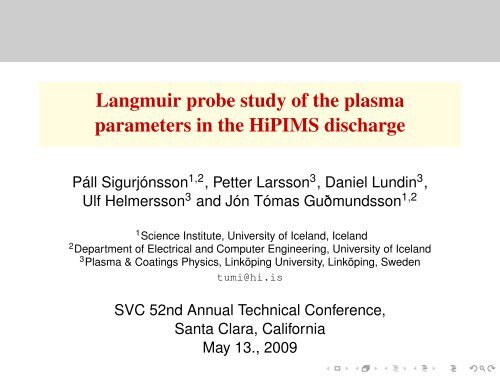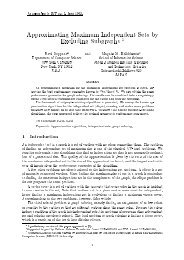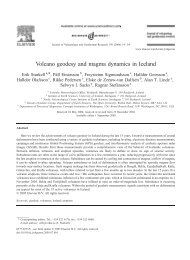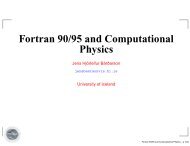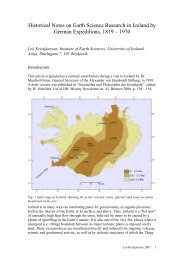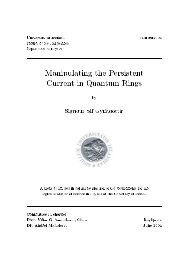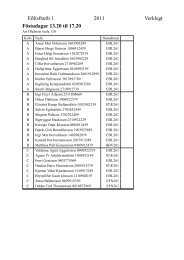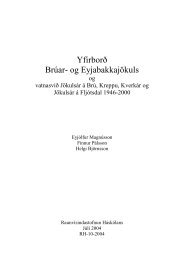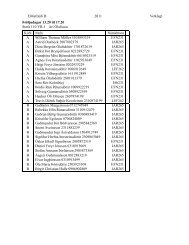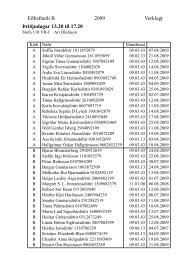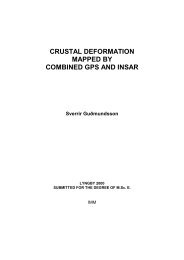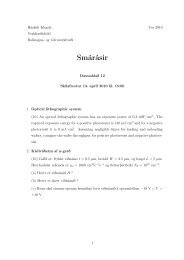Langmuir probe study of the plasma parameters in the HiPIMS ...
Langmuir probe study of the plasma parameters in the HiPIMS ...
Langmuir probe study of the plasma parameters in the HiPIMS ...
You also want an ePaper? Increase the reach of your titles
YUMPU automatically turns print PDFs into web optimized ePapers that Google loves.
<strong>Langmuir</strong> <strong>probe</strong> <strong>study</strong> <strong>of</strong> <strong>the</strong> <strong>plasma</strong><strong>parameters</strong> <strong>in</strong> <strong>the</strong> <strong>HiPIMS</strong> dischargePáll Sigurjónsson 1,2 , Petter Larsson 3 , Daniel Lund<strong>in</strong> 3 ,Ulf Helmersson 3 and Jón Tómas Guðmundsson 1,21 Science Institute, University <strong>of</strong> Iceland, Iceland2 Department <strong>of</strong> Electrical and Computer Eng<strong>in</strong>eer<strong>in</strong>g, University <strong>of</strong> Iceland3 Plasma & Coat<strong>in</strong>gs Physics, L<strong>in</strong>köp<strong>in</strong>g University, L<strong>in</strong>köp<strong>in</strong>g, Swedentumi@hi.isSVC 52nd Annual Technical Conference,Santa Clara, CaliforniaMay 13., 2009
Outl<strong>in</strong>edc Magnetron Sputter<strong>in</strong>g DischargeElectron densityElectron energy distributionHigh power impulse magnetronsputter<strong>in</strong>g discharge (<strong>HiPIMS</strong>)Summary <strong>of</strong> earlier workExperimental apparatus and setupPlasma <strong>parameters</strong> <strong>in</strong> <strong>the</strong> <strong>HiPIMS</strong>dischargeElectron densityElectron energy distributionPlasma potentialSummary
Planar dc Magnetron Sputter<strong>in</strong>g DischargeFor a typical dc planar magnetron dischargepressure <strong>of</strong> 1 – 10 mTorra magnetic field strength <strong>of</strong> 0.01 – 0.05 Tcathode potentials 300 – 700 Velectron density <strong>in</strong> <strong>the</strong> substrate vic<strong>in</strong>ity is 10 15 − 10 17 m −3low fraction <strong>of</strong> <strong>the</strong> sputtered material is ionized ∼ 1 %<strong>the</strong> majority <strong>of</strong> ions are <strong>the</strong> ions <strong>of</strong> <strong>the</strong> <strong>in</strong>ert gas<strong>the</strong> sputtered vapor is ma<strong>in</strong>ly neutral
Planar dc Magnetron Sputter<strong>in</strong>g Discharge10 19n e[m −3 ]T e[eV]10 1810 173 mTorr5 mTorr10 mTorr15 mTorr10 160 20 40 60 80 100 120 140z [mm]6543210 123 mTorr0T eh 5 mTorr510 mTorr15 mTorr1015Electron energy [eV]0T ecEEPF [eV (−3/2) /m 3 ]10 18 60402010 1610 1480120100z [mm]100 20 40 60 80 100 120 140z [mm](From Sigurjonsson and Gudmundsson (2008))The electron energy distribution is bi-Maxwellian
High Power Impulse Magnetron Sputter<strong>in</strong>g (<strong>HiPIMS</strong>)In a conventional dc magnetron discharge<strong>the</strong> power density is limited by <strong>the</strong><strong>the</strong>rmal load on <strong>the</strong> targetIn a <strong>HiPIMS</strong> discharge a high powerpulse is supplied for a short periodlow frequencylow duty cyclelow average powerThe high power pulsed magnetronsputter<strong>in</strong>g discharge uses <strong>the</strong> samesputter<strong>in</strong>g apparatus except <strong>the</strong> powersupply
High Power Impulse Magnetron Sputter<strong>in</strong>g (<strong>HiPIMS</strong>)The high power pulsed discharge operates with aCathode voltage <strong>in</strong> <strong>the</strong> range <strong>of</strong> 500 – 2000 VCurrent densities <strong>of</strong> 3 – 4 A/cm 2Power densities <strong>in</strong> <strong>the</strong> range <strong>of</strong> 1 – 3 kW/cm 2Average power 200 – 600 WFrequency <strong>in</strong> <strong>the</strong> range <strong>of</strong> 50 – 1000 HzDuty cycle <strong>in</strong> <strong>the</strong> range <strong>of</strong> 0.5 – 5 %
<strong>HiPIMS</strong> - Electron density - summary(After Gudmundsson et al. (2002))The electron density versus time from <strong>the</strong> <strong>in</strong>itiation <strong>of</strong> <strong>the</strong>pulse 9 cm below <strong>the</strong> targetThe pulse is 100 µs long and <strong>the</strong> average power 300 Wand <strong>the</strong> target made <strong>of</strong> tantalumA strong <strong>in</strong>itial peak appearsA second peak appears later <strong>in</strong> time at higher pressure
<strong>HiPIMS</strong> - Electron density - summaryA monotonic rise <strong>in</strong> <strong>plasma</strong> densitywith discharge gas pressure(Gudmundsson et al., 2002)applied power (Alami et al., 2005)A l<strong>in</strong>ear <strong>in</strong>crease <strong>in</strong> electron densitywith <strong>in</strong>creased discharge current(Ehiasarian et al., 2008)The electron density depends on <strong>the</strong>target materialCr target gives higher density than Ti(Vetushka and Ehiasarian, 2008)The peak electron density travels awayfrom <strong>the</strong> target with fixed velocity(Gylfason et al., 2005)(After Bohlmark et al. (2005))
<strong>HiPIMS</strong> - ExperimentThe goal <strong>of</strong> this work was to determ<strong>in</strong>e<strong>the</strong> temporal variation <strong>of</strong> <strong>the</strong>electron energy<strong>plasma</strong> potentialIn particular determ<strong>in</strong>e <strong>the</strong> electronenergy distribution function (EEDF)
<strong>HiPIMS</strong> - Power supply2000−2002502001503 mTorr5 mTorr10 mTorr15 mTorr20 mTorrV T[V]−400−600I T[A]100−800−1000−12000 20 40 60 80 100 120t [µS]3 mTorr5 mTorr10 mTorr15 mTorr20 mTorr500−500 20 40 60 80 100 120t [µS]The pulse generator was SINEX 2 from ChemfiltIonsputter<strong>in</strong>gThe exact pulse shape is determ<strong>in</strong>ed by <strong>the</strong> load<strong>the</strong> discharge formedit depends on <strong>the</strong> gas type and gas pressureThe average power was <strong>in</strong> <strong>the</strong> range 215 − 270 W, pulselength from 80 to 90 µs and repetition frequency was 50 Hz
Plasma <strong>parameters</strong> - <strong>Langmuir</strong> <strong>probe</strong>A <strong>Langmuir</strong> <strong>probe</strong> was used to <strong>study</strong><strong>the</strong> temporal and spatial variation <strong>of</strong><strong>the</strong> <strong>plasma</strong> <strong>parameters</strong>electron densityelectron energy<strong>plasma</strong> potentialThe <strong>Langmuir</strong> <strong>probe</strong>made <strong>of</strong> a sta<strong>in</strong>less steel wire,200 µm <strong>in</strong> diameter and 5 mm longThe voltage and current was measuredwith a 12-bit A/D converterFor each voltage step <strong>the</strong> currentdrawn by <strong>the</strong> <strong>probe</strong> was measured as afunction <strong>of</strong> time
Plasma <strong>parameters</strong> - <strong>Langmuir</strong> <strong>probe</strong>The EEDF was determ<strong>in</strong>ed from<strong>the</strong> Druyvesteyn formulag e (V ) = 2m ( ) 2eV 1/2d 2 I ee 2 A m dV 2The electron densityn e =∫ ∞0g e (E) dEThe effective electrontemperatureT eff = 2 3 〈E〉 = 2 ∫1 ∞Eg e (E) dE3 n e0The measured datawas filtered(Magnus and Gudmundsson, 2008)
<strong>HiPIMS</strong> - Electron density10 19 axial position [mm]10 19 axial position [mm](a)(b)n e[m −3 ]10 1810 17r = 0 mmr = 20 mmr = 40 mmr = 60 mm10 160 50 100 150n e[m −3 ]10 1810 17r = 0 mmr = 20 mmr = 40 mmr = 60 mm10 160 50 100 15065 µs230 µsThe spatial variation <strong>of</strong> <strong>the</strong> electron density at 65 µs and230 µs from <strong>the</strong> <strong>in</strong>itiation for gas pressure <strong>of</strong> 5 mTorr.The pulse is 90 µs long and <strong>the</strong> average power 270 W and<strong>the</strong> target made <strong>of</strong> copperThe electron density is uniform along <strong>the</strong> radius <strong>of</strong> <strong>the</strong>discharge
<strong>HiPIMS</strong> - Electron energyT eff[V]4.543.532.521.510.50(a)−0.50 50 100 150axial position [mm]r = 0 mmr = 20 mmr = 40 mmr = 60 mmT eff[V]4.543.532.521.510.50(b)−0.50 50 100 150axial position [mm]r = 0 mmr = 20 mmr = 40 mmr = 60 mm65 µs230 µsThe spatial variation <strong>of</strong> <strong>the</strong> effective electron temperatureat 65 µs and 230 µs from <strong>the</strong> <strong>in</strong>itiation for gas pressure <strong>of</strong> 5mTorr.The pulse is 90 µs long and <strong>the</strong> average power 270 W and<strong>the</strong> target made <strong>of</strong> copperThe effective electron temperature is uniform along <strong>the</strong>radius <strong>of</strong> <strong>the</strong> discharge
<strong>HiPIMS</strong> - Plasma potentialV pl[V]6543210−1(a)0 50 100 150axial position [mm]r = 0 mmr = 20 mmr = 40 mmr = 60 mmV pl[V]6543210−1(b)0 50 100 150axial position [mm]r = 0 mmr = 20 mmr = 40 mmr = 60 mm65 µs230 µsThe spatial variation <strong>of</strong> <strong>the</strong> <strong>plasma</strong> potential at 65 µs and230 µs from <strong>the</strong> <strong>in</strong>itiation for gas pressure <strong>of</strong> 5 mTorr.The pulse is 90 µs long and <strong>the</strong> average power 270 W and<strong>the</strong> target made <strong>of</strong> copper
<strong>HiPIMS</strong> - Electron energyThe electron energy probability function (EEPF) under <strong>the</strong>race-track 100 mm below <strong>the</strong> target for an argon dischargeat 3 (dashed) and 20 (solid) mTorr with a copper target
<strong>HiPIMS</strong> - Electron energyThe measured EEPF is Maxwellian-like dur<strong>in</strong>g <strong>the</strong> pulsehigh electron density leads to a Maxwellian-like low energypart <strong>of</strong> <strong>the</strong> EEPF<strong>the</strong> depletion <strong>in</strong> <strong>the</strong> high energy part is due to <strong>the</strong> escape <strong>of</strong>high energy electrons to <strong>the</strong> chamber walls and <strong>in</strong>elasticcollisions <strong>of</strong> high energy electronsThe EEPF is more broad at low pressure and early <strong>in</strong> <strong>the</strong>pulse
<strong>HiPIMS</strong> - Electron energyTemporal variation <strong>of</strong> <strong>the</strong> effective electron temperature100 mm below <strong>the</strong> target under <strong>the</strong> race-track (r = 40 mm)Argon discharge at 3 and 20 mTorr with a copper targetThe electron energy decreases with <strong>in</strong>creased dischargepressure
<strong>HiPIMS</strong> - Electron energyDur<strong>in</strong>g <strong>the</strong> <strong>in</strong>itial stages <strong>of</strong> <strong>the</strong>pulse Ar + ions dom<strong>in</strong>ate <strong>the</strong>dischargeLater <strong>in</strong> <strong>the</strong> pulse metal ionsbuild up and become <strong>the</strong>abundant ion speciesThe high metal content isexpected to cool <strong>the</strong> EEPFdue to electron impactexcitation and ionization <strong>of</strong><strong>the</strong> metal atoms, that havemuch lower excitationthresholds and ionizationpotential than <strong>the</strong> argonsputter<strong>in</strong>g gasFrom Bohlmark et al. (2006)From Ehiasarian et al. (2002)
SummaryWe discussed <strong>Langmuir</strong> <strong>probe</strong> measurements <strong>of</strong> <strong>the</strong><strong>plasma</strong> <strong>parameters</strong> <strong>of</strong> <strong>the</strong> high power impulse magnetronsputter<strong>in</strong>g discharge (HIPIMS)The electron densityroughly 1 – 3 orders <strong>of</strong> magnitude higher than <strong>in</strong> a dcmagnetron sputter<strong>in</strong>g dischargeThe electron energy distribution function (EEDF)is Maxwellian-like dur<strong>in</strong>g <strong>the</strong> pulseThe electron energyis below 1 V towards <strong>the</strong> end <strong>of</strong> <strong>the</strong> pulse probably due tohigh metal content <strong>in</strong> <strong>the</strong> discharge
AcknowlegdementsCan be downloaded athttp://www.raunvis.hi.is/∼tumi/hipims.htmlThe photographs were taken by Árni S. Ingason, Páll Sigurjónsson and Krist<strong>in</strong>n B. Gylfason.This work was partially supported by <strong>the</strong> Icelandic Research Fund <strong>the</strong> University <strong>of</strong> Iceland Research Fundand <strong>the</strong> Swedish Research Council.
ReferencesAlami, J., J. T. Gudmundsson, J. Bohlmark, J. Birch, and U. Helmersson (2005). Plasma dynamics <strong>in</strong> a highlyionized pulsed magnetron discharge. Plasma Sources Science and Technology 14(3), 525–531.Bohlmark, J., J. T. Gudmundsson, J. Alami, M. Latteman, and U. Helmersson (2005). Spatial electron densitydistribution <strong>in</strong> a high-power pulsed magnetron discharge. IEEE Transactions on Plasma Science 33(2),346–347.Bohlmark, J., M. Lattemann, J. T. Gudmundsson, A. P. Ehiasarian, Y. A. Gonzalvo, N. Brenn<strong>in</strong>g, and U. Helmersson(2006). The ion energy distributions and ion flux composition from a high power impulse magnetron sputter<strong>in</strong>gdischarge. Th<strong>in</strong> Solid Films 515(5), 1522–1526.Ehiasarian, A. P., R. New, W.-D. Münz, L. Hultman, U. Helmersson, and V. Kouznetzov (2002). Influence <strong>of</strong> highpower densities on <strong>the</strong> composition <strong>of</strong> pulsed magnetron <strong>plasma</strong>s. Vacuum 65, 147–154.Ehiasarian, A. P., A. Vetushka, A. Hecimovic, and S. Konstant<strong>in</strong>idis (2008). Ion composition produced by high powerimpulse magnetron sputter<strong>in</strong>g discharges near <strong>the</strong> substrate. Journal <strong>of</strong> Applied Physics 104(8), 083305.Gudmundsson, J. T., J. Alami, and U. Helmersson (2002). Spatial and temporal behavior <strong>of</strong> <strong>the</strong> <strong>plasma</strong> <strong>parameters</strong><strong>in</strong> a pulsed magnetron discharge. Surface and Coat<strong>in</strong>gs Technology 161(2-3), 249–256.Gylfason, K. B., J. Alami, U. Helmersson, and J. T. Gudmundsson (2005). Ion-acoustic solitary waves <strong>in</strong> a pulsedmagnetron sputter<strong>in</strong>g discharge. Journal <strong>of</strong> Physics D: Applied Physics 38(18), 3417–3421.Magnus, F. and J. T. Gudmundsson (2008). Digital smooth<strong>in</strong>g <strong>of</strong> <strong>the</strong> <strong>Langmuir</strong> <strong>probe</strong> I-V characteristic. Review <strong>of</strong>Scientific Instruments 79(7), 073503.Sigurjonsson, P. and J. T. Gudmundsson (2008). Plasma <strong>parameters</strong> <strong>in</strong> a planar dc magnetron sputter<strong>in</strong>g discharge<strong>of</strong> argon and krypton. Journal <strong>of</strong> Physics: Conference Series 100, 062018.Vetushka, A. and A. P. Ehiasarian (2008). Plasma dynamic <strong>in</strong> chromium and titanium HIPIMS discharges. Journal <strong>of</strong>Physics D: Applied Physics 41(1), 015204.


